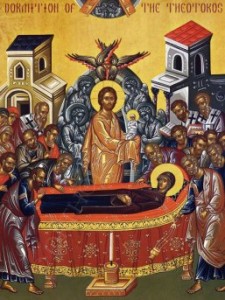 If I were to pick one item of teaching or practice that best marks the distinction between Protestants and the more ancient traditions of Christianity it would have to be Jesus’ mom.
If I were to pick one item of teaching or practice that best marks the distinction between Protestants and the more ancient traditions of Christianity it would have to be Jesus’ mom.
She’s huge to both Orthodox and Catholic Christians. Protestants? Not so much.
Not too long ago I heard a Protestant sermon in which the preacher was emphasizing important women in the Bible. Each of a dozen or so got a short remembrance. And that’s good: we do tend to only emphasize the contributions of the boys.
But guess who was not even mentioned in a sermon on the most important women of the Bible?
Mary: the woman on whom salvation history hinges.
I mean Mary was chosen by God to bear God’s only begotten Son, truly human and truly God, the savior of the world.
This is a very big deal. If Mary had said “No thanks” to Gabriel, we would all be sunk.
We are so concerned by Catholic excesses about Mary that we often won’t mention her at all — even when recounting important women of the Bible.
You’d think we didn’t actually like her.
So August 15 just a hot summer day for Protestant Christianity. It is one of the most important feasts for Orthodox and Catholic Christians.
What’s your Assumption about the “Dormition”?
Orthodox call August 15 “The Dormition of our Most Holy Lady the Mother of God and Ever-Virgin Mary.” Catholics call it “The Assumption of the Virgin Mary into Heaven.”
You can piece together the Orthodox tradition’s version of Mary’s story from the hymns and prayers from Matins, or Morning Prayer, for the feast.
(You can get a fuller exposition of the tradition from the OCA website, though if you happen to be a historian you will at least smile at the use of sources.)
It goes something like this:
- Mary was much beloved of the Apostles because Christ was born of her.
- From Mary came Jesus’ humanity, while from his Father came Jesus’ divinity.
- Mary died.
- Rather than decaying, her body emitted a sweet scent.
- Mary’s soul was miraculously seen ascending to Jesus.
- Mary’s body was buried in a tomb.
- When the tomb was opened, her body was gone — ascended into heaven.
The thing is, we Protestants really should be fine with most of this. Only points 4, 5 and 7 should surprise anybody.
It is our post-Enlightenment assumptions about history that leaves us troubled by sweet fragrances from saints’ bodies, visions of heaven, and miraculous ascensions.
We might be okay with these things when the Bible mentions the same things — with Lazarus, Stephen, and Elijah for instance. But when they have just been passed down by faithful Christians we raise an eyebrow.
Personally I love Mary. I think she has an amazing place in salvation history.
I am not surprised in the least that ancient Christians sang her praise. It makes perfect sense that Christians would be drawn to the tenderness of the woman who nurtured Jesus himself.
If we want to be like Jesus, we should love what Jesus loves.
That probably starts with his mom, right?

Through the intercession of the Theotokos, Savior save us!
Thanks Fr. Dustin. (I miss singing that with you!)
An aspect of Mary that I’ve recently come to appreciate is that she was present at her son’s crucifixion, standing at the Cross. I came about this through the Arvo Part’s Stabat Mater. Reading the words at wikipedia, only a couple lines cause me any pause; the vast majority invite me to join her there.
I’ve always liked Mary: a model for prayer (pondering things in her heart) and The Magnificat makes her into a prophetic figure.